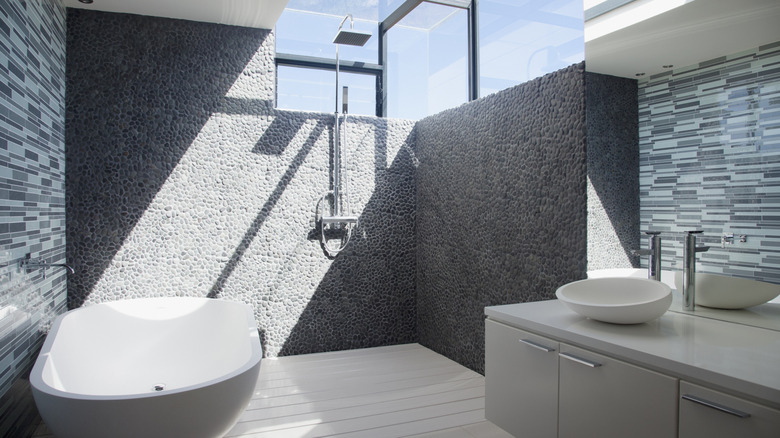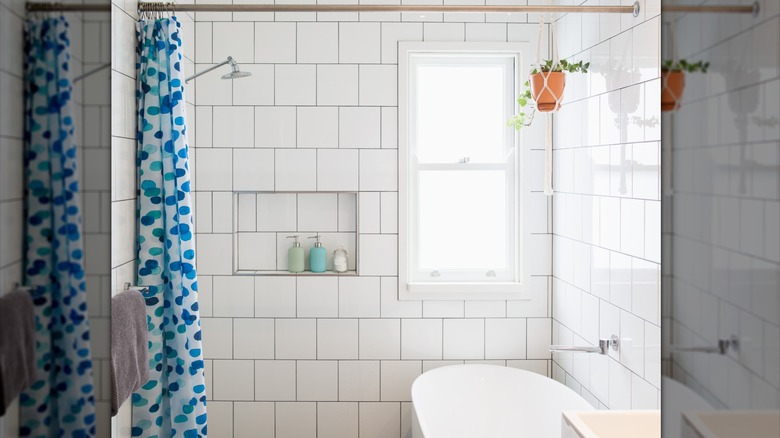Short On Space? What To Know Before Fitting A Tub Into Your Shower
Most people have a preference when it comes to their bathing habits — especially when the goal is to leave feeling relaxed and renewed. That said, if anything is kicked to the curb in a small bathroom, it is usually the tub. This is because it takes up more space and is generally less practical than a shower (you can't realistically take a five minute bath, or even if you could, the water usage wouldn't be worth it). But if you are hoping to have both in your space, there is another alternative to a hybrid bath/shower combo or having them completely separate. Instead, you can place your bathtub inside the shower. With this option, you won't have to step into the tub to take a shower. Instead, the tub will be inside the walk-in shower area. This is also sometimes called a "wet room."
However, while there are some compelling reasons to consider adding a wet room to your bathroom — a luxurious feel, good use of space, and ease of cleaning, for example — you should also know the downsides like the high cost and drainage/humidity needs before diving into a renovation. Depending upon your given space, budget, and goals, there are some pretty definitive factors that can help you to determine if this is the right direction for your bathroom. Here's what you need to know to make the decision to either bring your bath and shower closer or keep them apart.
Benefits of placing a tub in your shower
Though less popular in the United States, putting a tub in the shower isn't a new concept. The "wet room" is a sleek, waterproofed room that combines the shower and bathtub, popular in spas, luxury hotels, and European homes. Not only does this have a high-end feel, but it can also be surprisingly space saving as it pushes the tub and shower to one portion of the room instead of spreading them out completely. This may seem insignificant, but especially when working with a tight or awkward space, it can make a world of difference. In a traditional wet room, you don't even have a shower enclosure — rather, the whole room is open and water-friendly, so you truly get the most out of your space.
Besides aesthetics and space-saving factors, some say that combining your tub and shower can make it easier to clean your bathroom, as your bathing is contained to a single space. This may be especially true for small bathrooms, as the area won't be as large. If you are diligent and choose the right shower head, ideally one with a handheld option, giving it a consistent rinse down can significantly decrease the need for a serious scrub.
Downsides to consider before combining your tub and shower
If you are looking to do this in your own home, you will probably want to hire a contractor unless you are very well versed in home renovations and construction. You will need to carefully consider the right layout in your small space for functionality and aesthetics. Installation can also be a large undertaking with a good amount of room for error if not done properly. The last thing you want to cause with a bathroom upgrade is water damage to other areas of your home. Therefore, even if going the DIY route might initially be cheaper, it's better to be safe than sorry. Since wet rooms need to be waterproofed, they are essentially a giant shower, which can get quite pricey. They are typically fully tiled from floor to ceiling, so even when using a more affordable tile in a small bathroom, this can add up quick.
You also have to be careful to ensure that your floor is level — if not, you can end up with water pooling and improper drainage, which is a headache to fix once installed. Furthermore, since there is so much humidity and water in one spot, wet rooms also require a better ventilation system than a typical bathroom to prevent mold, mildew, and water damage to the rest of the space.

